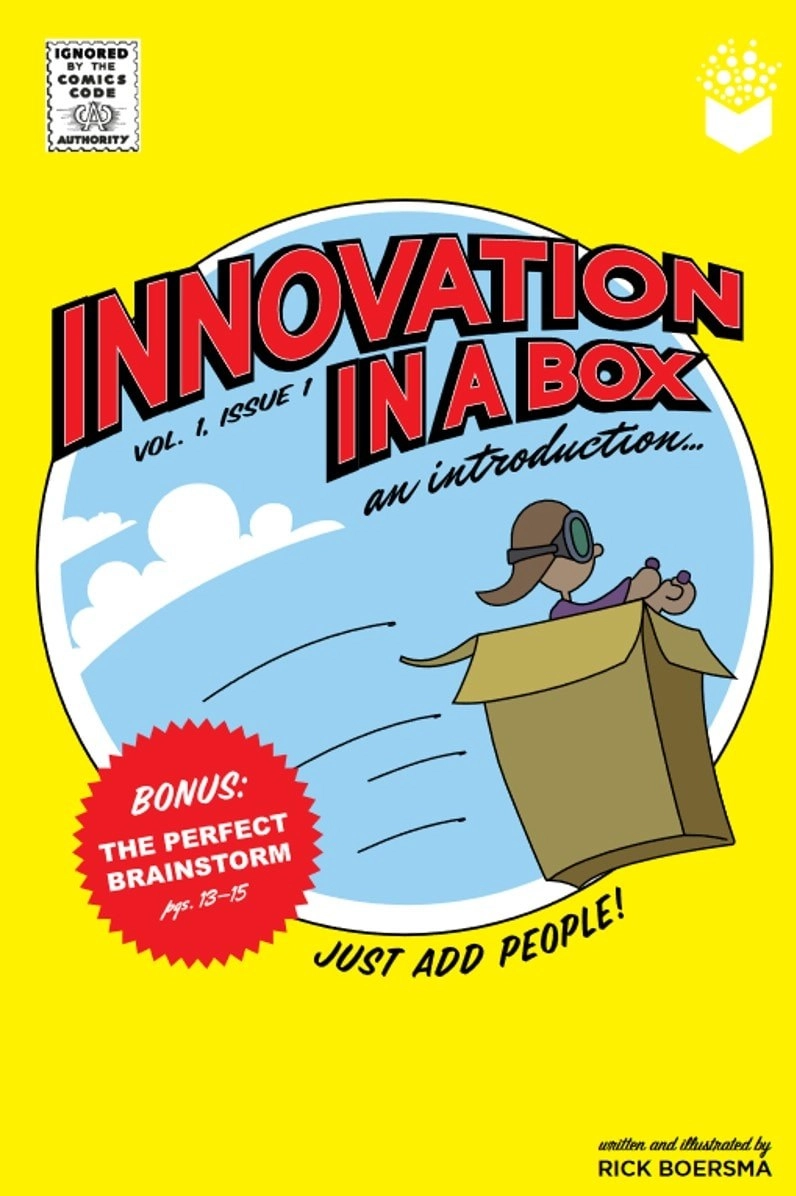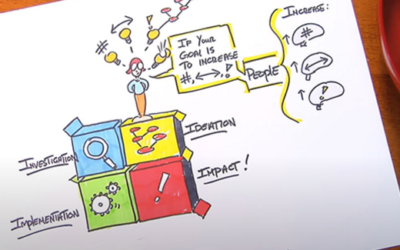
A 5-Step Innovation Process That Fuels Employee Engagement Every Day
Summary
Brainstorming sessions that simply ask people to “blue sky” or “think outside the box” can feel like a real energy drain and impact people’s engagement with the innovation. A structured innovation process not only provides a guide to fuel everyday innovation, it can fuel employee engagement and energize your teams.
Sections:
- So What is Innovation?
- Fuel Employee Engagement Through Everyday Innovation
- Swap Hard-to-Decode Innovation Frameworks for a Simple DIY Innovation Process
- Introduction to a New Everyday Innovation Process
So What is Innovation?
Have you ever noticed how quiet a brainstorming session gets when a group is asked to simply “think outside the box” or to “be more creative”? For many, the term “innovation” can be intimidating. Employees often associate innovation as a superpower reserved for “creative people” and those who have the word innovation in their job title. Or that innovation is only about making world-changing products.
Innovation is not necessarily “invention”. Innovation simply means bringing fresh thinking to a process, situation, or challenge.
Of course, developing world-changing products is innovative. But innovation is much broader than that – it’s also about evolving core processes, solutions and internal systems. So, even if your organization or team isn’t in the business of making world-changing products, your teams and employees can still create value by fueling innovative thinking every day.
We’ve all seen those memes of a lightbulb floating above an inventor’s head. Images like these have made us believe that innovation is a random “lightbulb moment” – a flash of brilliance that suddenly presents itself; or that innovation is about coming up with a singular “right” idea. In reality, innovation is not random and, while an individual idea may be great (and great ideas are certainly an element of innovation), ideas in isolation do not add value.
We’d like to introduce you to a new way of thinking about innovation and the approach we use that blends openness, collaboration, focus and structure to help teams fuel innovative thinking and generate breakthrough solutions.
Fuel Employee Engagement Through Everyday Innovation
Making innovation accessible for people starts with demystifying the term. Innovation defined as “ideas that, when implemented, add value” to the organization, means that you can take the pressure off yourself and your teams. You don’t need to aim for a lightbulb flash-of-brilliance moment. Instead, consider innovation a discipline that allows teams to leverage a simple, structured process that broadens and energizes their view of how to approach everyday problems, issues, and opportunities.
By leveraging a structured process, people become more likely to engage with problems and opportunities in a productive way. Instead of being some mysterious, complex, and random occurrence, innovation becomes built into their day-to-day way of working. The result? An energized workforce that challenges the status quo, uncovers breakthrough solutions, and produces more useful ideas that get implemented and add value every day.
How does a structured and clear process support innovation?
Brain science tells us that we can perceive ambiguity as risky or even as a threat. When we know the lay of the land and have a clear goal, we can relax, which frees up brain capacity to be creative and be willing to consider alternatives. We’re more open to change and energy gets unlocked, making it easier to get into a state of flow (focused, productive and less self-conscious).
Without a defined process, innovation can be a real energy drain on teams. Brainstorming sessions that simply ask folks to “blue sky” or “think outside the box” can set off a number of unhelpful team dynamics: some people may shut down completely, some may dominate the conversation, while others may shoot down ideas before they’ve had a chance to be considered. A structured process, like our i5 innovation process, not only provides a guide to fuel everyday innovation, but it also has another very important side effect: it can fuel employee engagement and energize your teams.
Imagine the feeling when a group finds their flow. There’s a buzz in the room as they build on each other’s ideas, and generate possibilities. And when a team solves a long-standing problem or issue, or identifies a better way of doing things, it releases neurochemicals in the brain (dopamine to be exact) which unlocks the energy needed to fuel ongoing ideas and value creation. It can become a self-fueling engine.
Swap Hard-to-Decode Innovation Frameworks for a Simple DIY Innovation Process
You don’t need a complex innovation framework for your people and teams to engage with innovation: with a simple, structured process powered by practical tools, anyone and everyone can engage with innovation. That is, anyone and everyone can contribute to ideas that can be converted into real, tangible value to your organization.
From our work with clients, we know there are a number of challenges that block innovation. Your organization may have innovation as a strategic priority, but we know (because they tell us all the time) people aren’t clear on where to start, or have too limited a view of what constitutes innovation. Those that do try to engage in innovation, tend to jump to solutions too quickly. Others stick to their departmental silos rather than collaborating with other relevant groups to ensure more breakthrough (and successful) solutions.
A simple, structured process addresses these common blocks and equips teams to move from ideation to implementation in these important ways:
- Fueling creativity. For those who may not believe they are a “creative person,” a structured process expands perspectives and provides a level of focus that draws out their natural creativity. This is the paradox of innovation…provide structure to “free” people’s thinking and creativity.
- Providing a solid starting point. A structured process provides a starting point to generate new ideas, as well as the scaffolding to intelligently build out those ideas.This allows the team to focus on their ideas and how to bring them to life, rather than figuring out what process to follow. Sometimes the biggest challenge is knowing where to start – an easy-to-follow process can overcome the initiation energy required to generate momentum.
- Offering clarity and direction. To get to a truly value-added solution, it is critical for the team to focus on the right problem and this step often gets rushed or skipped altogether. A structured process allows you to save time and resources, and increases the chances of success, by making sure everyone is clear about the problem they are trying to solve. This clarity keeps the team focused on solving the right problem.
- Fostering collaboration. It can often feel easier for a team to work in their own departmental silo – it’s less complex and seems like it will create less friction (at least initially). A structured process can enhance cross-functional collaboration by keeping everyone focused on what matters most at each stage of the innovation process. Without this, groups can find themselves frustrated at implementation as they compete for their needs to be heard and try to make sense of everyone’s input. Innovating together reduces friction and ensures that collaboration is a natural part of the process, rather than an afterthought.
- Guiding teams to the best solution. A methodical process with defined steps forces teams to stress-test their potential solutions to ensure they will address the problem at hand in the most original and comprehensive way. A simple methodology prevents teams from jumping to implementation too quickly.
A Simple Innovation Process & Tools To Help Anyone Innovate
It’s not enough to say “Think outside the box!”. If we expect people to think outside of their boxes, we need to provide them with a new box (or boxes) that provide the the support they need to effectively engage with innovation. That’s where the structured i5 process and tools comes in. Watch the video and explore how Innovation in a Box can help you fuel every day innovation within your organization.
Introduction to a New Everyday Innovation Process
Our innovation training process provides teams with a clear guide for how to approach a problem or an opportunity, and equips them with easy-to-use tools to work through each step in the process. By identifying and defining each phase of the innovation journey, the team can work through each step methodically and at a pace that works for them and the organization. The specific stages of the i5 process are:
1. Identification
One of the key challenges we see when teams try to innovate is the impulse to jump to solutions too quickly. As a result, people can invest a lot of energy moving forward with a solution that doesn’t address the most important aspects of the problem or opportunity. The identification stage, and associated tools, are designed to help the team slow down, explore the many facets of a problem or opportunity, and then select the ideas that will generate the greatest value.
2. Investigation
To create truly innovative solutions, the team needs to invest time in thoroughly understanding the problem or opportunity they are trying to solve. Too often, we see teams trying to ideate or generate solutions without a solid understanding of the problem. Gaining a deeper understanding of the problem forms the fuel for generating value-adding ideas.
3. Ideation
What we know about the innovation process is that the first idea is rarely the best, value-adding idea. In fact, in order to get to original ideas, the team needs to generate a lot of them. The ideation stage, and associated tools, are about moving the team’s thinking beyond status quo. It’s about divergence: we’re not looking for the right idea; we’re looking to generate as many ideas as possible. This isn’t just about standing at a flip chart and “blue skying”; our ideation tools provide thought-provoking questions and specific brainstorming techniques that structure the discussion, maximize participation, and encourage divergent thinking.
4. Impact evaluation
At the end of a productive brainstorming session, the team is often energized by the volume of ideas they’ve created. But it is also at this point in the process when many teams can get stuck, overwhelmed by the volume of ideas they’ve uncovered. The impact evaluation stage equips the team to evaluate their ideas by selecting criteria, or “filters” to guide their analysis and to choose the best idea(s) to move forward.
Filtering ideas
In the impact evaluation stage, the team gets clear on their evaluation criteria, or “filters”. For example, the iPhone likely had the filter of “change the world”, whereas many internal projects might have a filter of “we need to be able to execute this by Monday”. Both can be innovative – the team just needs clarity on the criteria to sift through the ideas they’ve generated and decide which 2-3 ideas they want to pursue.
5. Implementation
Let’s go back to our definition of innovation – ideas that, when implemented, add value to the organization. Developing a practical, actionable plan to implement the best solution is critical. After all, ideas alone are not innovation; it’s only when they’re implemented that they generate value. The implementation phase helps everyday innovators communicate their business case and action plan effectively, which includes the plan for getting frequent input as they test and learn throughout the process. This provides leaders and key decision makers with the information they need to properly assess the potential value of an idea and to support a plan to move it forward.
A Note About Implementation
Implementation may not mean a full-scale implementation right out of the gate. Depending on the type and potential impact of the solution, you may want to encourage the team to test their idea(s) before settling on a final solution. This might involve gathering more information, conducting experiments, or creating prototypes to test their ideas. It’s important to encourage a culture of experimentation and iteration, where small, low-risk experiments are encouraged and celebrated. This can help foster a mindset of continuous improvement, where even small changes or tweaks can have a big impact over time.
We’ve presented the i5 process above as a series of five steps, but the process and tools can be used in a number of different ways. Some of our clients treat the process like a linear “recipe” or set of best practices: they start at step 1 and work through to step 5. Many others love the purpose-built tools and will mix and match, treating each one as its own discrete bucket of work. They like that they can pull out the right tool when they need to move through a log-jam in a team meeting or infuse some fresh thinking.
The nice thing is, the process and tools are there to support you in different ways, at different times, depending on the situation or challenge at hand. There may be times when the team can flow through the stages in order but, more often than not, everyday innovators need to be comfortable moving back and forth between the steps as they work through their challenges, gather new information, incorporate feedback, or adjust to the ever-changing business landscape.

ILLUSTRATED GUIDE
An Introduction to the i5 Process and Innovation Tools
People have a tendency to freely swap the terms problem solving and innovation. But they’re not the same. Problem solving is reactive while Innovation is proactive. And while problem solving is necessary for survival, all it really does is maintain the status quo. True innovation is future-focused and transcends the status quo.
Start your journey with fueling every day innovation with this graphically rich introduction to innovation, the i5 process and the practical tools that will help you and your team deliver breakthrough ideas.
Ready to Change How Your Organization Innovates?
Equip your teams to be everyday innovators and introduce them to an easy-to-use structured approach, powered by a practical process and tools. You can help your team members feel comfortable, confident, and motivated to be more innovative every day.
Your content is only one click away.
Thanks for your interest in our content. We hope you find value in the time you invest with it. Click the button below and get immediate access to this truly valuable content.
Complete the form below and get instant access to this game-changing content.
Rest assured, we take your privacy seriously and will never sell, trade, or share your information with a third party.




